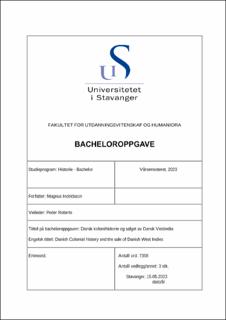| dc.contributor.advisor | Roberts, Peder. | |
| dc.contributor.author | Indridason, Magnus. | |
| dc.date.accessioned | 2023-07-04T15:51:36Z | |
| dc.date.available | 2023-07-04T15:51:36Z | |
| dc.date.issued | 2023 | |
| dc.identifier | no.uis:inspera:146729805:65436749 | |
| dc.identifier.uri | https://hdl.handle.net/11250/3075619 | |
| dc.description.abstract | Denne Bacheloroppgaven handler om dansk kolonihistorie og hva danske medier skrev om salget av Dansk Vestindia til USA i 1917. Kolonihistorie er fortsatt et aktuelt tema i dag med danske aksjonister som maler statuer av Grønlandsmisjonær Hans Egede med budskapet «Decolonize» og Black Lives Matter-protester i USA. Etter å ha fått interessen for dansk kolonihistorie etter å ha sett dokumentaren Slaveskipet - Norges mørke kolonihistorie på NRK TV. Ville jeg se nærmere på salget av Dansk Vestindia til USA. Hvordan dette salget kom i stand, hvorfor det ble salg og hvordan salget ble framstilt i danske medier. Jeg kommer til å se på hva danske mediene skrev om dette salget og andre hendelser i Dansk Vestindia i ukene etterpå. Salget ble annonsert signert og annonsert av President Woodrow Wilson og utenriksminister Robert Lansing den 16. januar 1917. Jeg har tenkt å se på hva den satiriske avisen Klod-Hans framstilte salget, et knippe danske aviser skrev i uken salget skjedde, altså 15 til 21 januar og uken etterpå altså fra 22 januar til 28 januar. Hva opptok medier angående Dansk Vestindia og hvordan ble dette fremstilt.
I 1792 forbøy Danmark med kongelig resolusjon slavehandel og etter en 10 årsperiode ble det innført forbud mot slavehandel i det danske riket den 1. januar 1803. Dette gjorde at dansk Vestindia mistet sin verdi for Danmark, i tillegg til et slaveopprør i 1849, fallende sukkerpriser og store sosiale problemer på øyene prøvde Danmark lenge å få solgt øyene. Det var ikke før i 1917 at USA til slutt kjøpte øyene for 25 millioner dollar.
Danske aviser skrev i perioden 15. januar til 28 januar en del om Dansk Vestindia deriblant at avtalen om salget var i orden og at øyene nå skulle skifte navn. En slik historisk hendelse ble ikke framstilt annerledes enn en «vanlig» nyhetssak i danske aviser på denne tiden. Jeg vil ut fra dette trekke konklusjonen om at dansk media hadde en nøytral framstilling over salget av dansk Vestindia til USA og at sorgprosessen over tapet av øynene var for lengst forsvunnet. På framsiden av Klod-Hans og tegningen Den rige mister Wilson, kan man se litt bitterhet ved å miste øyene. | |
| dc.description.abstract | This Bachelor thesis is about Danish colonial history and what the Danish media wrote about the sale of the Danish West Indies to the USA in 1917. Colonial history is still a relevant topic today with Danish activists painting statues of Greenland missionary Hans Egede with the message "Decolonize" and Black Lives Matter protests in the United States. After becoming interested in Danish colonial history after watching the documentary Slaveship - Norway's dark colonial history on NRK TV. I would like to take a closer look at the sale of the Danish West Indies to the USA. How this sale came about, why it was sold and how the sale was portrayed in the Danish media. I will look at what the Danish media wrote about this sale and other events in the Danish West Indies in the weeks that followed. The sale was announced signed and announced by President Woodrow Wilson and Secretary of State Robert Lansing on January 16, 1917. I intend to look at what the satirical newspaper Klod-Hans portrayed the sale, a bunch of Danish newspapers wrote in the week the sale happened, that is 15 to 21 January and the week after, i.e. from 22 January to 28 January. What did the media take up regarding the Danish West Indies and how was this portrayed.
In 1792, Denmark banned the slave trade with a royal decree and after a 10-year period, a ban on the slave trade was introduced in the Danish kingdom on 1 January 1803. This made the Danish West Indies lose its value for Denmark, in addition to a slave revolt in 1849, falling sugar prices and major social problems on the islands, Denmark tried for a long time to sell the islands. It wasn't until 1917 that the United States finally bought the islands for $25 million.
In the period from 15 January to 28 January, Danish newspapers wrote a section about the Danish West Indies, including that the agreement on the sale was in order and that the islands were now to change their name. Such a historical event was presented no differently than a "normal" news story in Danish newspapers at the time. I would like to draw the conclusion from this that the Danish media had a neutral presentation of the sale of the Danish West Indies to the USA and that the mourning process over the loss of the eyes had long since disappeared. On the front of Klod-Hans and the drawing Den rige mister Wilson, one can see a little bitterness at losing the islands. | |
| dc.language | nob | |
| dc.publisher | uis | |
| dc.title | Dansk kolonihistorie og salget av Dansk Vestindia | |
| dc.type | Bachelor thesis | |
